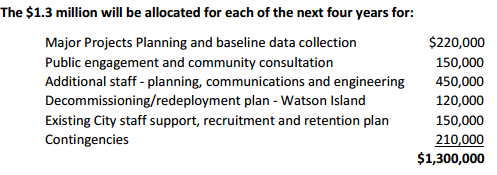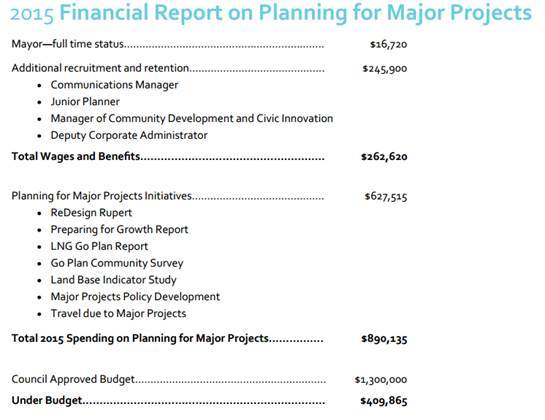Here’s the Mayor’s response, sent via e-mail.
TAXES
To start, City Council did not raise taxes this year. We voted 6-1 for a 0% increase for the first time in recent memory. Unfortunately, the BC Assessment valuations did go up, and if people’s property values went up over 10% of the average, then they most likely saw an increase in payment.
WAGES
In the spring of 2015, City Council passed a resolution to create a new Planning for Major Projects budget to ensure the City has capacity to address the speculative growth within the City of Prince Rupert and the region, without impacting the taxpayers. The Planning for Major Projects Budget is $1.3 million per year for a four year period (2015-2019), funded from the proceeds of a lease option with WCC LNG for Lot 444 through Prince Rupert Legacy fund. With the potential LNG facilities being proposed for the area comes tremendous constraints being placed on City staff to manage our daily priorities along with the longer term planning required for community success in the face of proposed growth.
As such, Council identified various needs in preparing for unprecedented growth which include a requirement for additional staffing, specifically around planning and engineering. Within this decision was the installation of a four year ‘sunset’ clause which will retire the Planning for Major Projects Budget should there be no confirmed LNG activity, thereby returning staff support to their previous levels. The formal term for this action is called a temporary market adjustment, meant to act as a recruitment and retention tool during a time of significant competition for talented workers. Recognizing the possibility that interest from LNG and other major industries may decline, City Council intentionally set an expiry date on the wage increases that allows us to return to ‘business as usual’, with benefits accrued from the planning and engineering work.
A breakdown and explanation of this budget was published with a press release in the spring of last year, in addition, it was physically mailed out to each homeowner in last year’s Tax Notice sent by the City:
http://princerupert.ca/cityhall/news/may-11-2015-spring-2015-community-update
Here’s a quick breakdown of the budget:

You can now view how we spent the Planning for Major project budget for 2015 here:
http://princerupert.ca/cityhall/prince-rupert-legacy-inc

Here are two key examples of the changes in salary for the City’s top leadership:
MAYOR’S WAGE
Actual wage (Operations Budget): $42,000/year
Temporary wage increase (2015-2019 PMP Budget): $17,000 authorized to be paid out of the budget of the Prince Rupert Legacy fund, funded by the lease option on Lot 444, not taxpayers.
Total city wage: $60,000
The travel component of my expenses, as reported in the SOFI, was additionally broken down here: Mayor Lee Brain - Hi folks, it's that time of year where the City of Prince Rupert produces our SOFI (Statement of Financial Information) report. Usually the report does not mention the details of where the mayor has traveled, just the total cost, so I decided to create a graph to show folks where I went and why during 2015. For 2015, you may notice my travel expenses have increased from previous years. This is a direct result of the many developments being proposed in Prince Rupert. This required an above average amount of travel taken in order to participate in LNG-related negotiations and advocate for investment in infrastructure and social programming for Prince Rupert to other levels of government so that we are adequately prepared for growth. In 2015 I traveled several times to meet with Ministers from both levels of government and proponents related to proposed developments. These additional expenses are taken from the Planning for Major Projects budget, money specifically set aside from the lease option on Lot 444, so that the taxpayers are not adversely impacted. Meanwhile, Operational travel expenses are those that a Mayor in any given municipality generally incurs for attending conferences and events that are in relation to the day-to-day operations of a City. This includes attending local government conferences where municipalities come together to advocate for shared interests like the North Central Local Government Association (NCLGA), the Union of BC Municipalities (UBCM) and the Federation of Canadian Municipalities (FCM) conferences. Each travel location includes flight costs (average $700 round-trip from Prince Rupert to Vancouver) or vehicle travel, hotel costs, conference registration fees, daily food per diem and any taxi costs, as per the City's travel policy. I look forward to continuing to serve the best interests of Prince Rupert and to advocate on our behalf to all levels of government in order for us to see the best possible social and economic outcomes for our community. In your service, Mayor Lee Brain | Facebook - that was also broken down between the PMP budget and operations.
In other cities of a similar size, the mayoral position is part-time. The current situation relating to our workload demands is unique and temporary, which is why council voted in favour of making the position full-time for a period of four years.
In addition, I was also remunerated by the SQCRD for $12,918 for regional district duties.
CITY MANAGER
Actual wage (Operations Budget): $180,000
Temporary wage increase (2015-2019 PMP Budget): $45,000
Total wage: $225,000
Although the SOFI says he made $254,797, the remaining amount represents benefits and carry-over of holidays from the previous year (taxable benefits).
We have a new management team, a new group dynamic, and cohesion happening at City Hall like never before. Many of our managers work long hours, are on call, and respond to issues after hours and even on vacation. City council and management have dedicated resources to retaining our top staff to ensure core employees stay with the City and continue to do good work on behalf of the residents.
RESULTS
Since the election in December 2014, Council and administration have brought in nearly $23 million dollars of new funding for infrastructure. We’ve invested in roads, water and are taking an aggressive approach to revitalizing and rebuilding this community. We’ve launched new programs like Re:Design Rupert to get the public engaged, and Re:Build Rupert to fix aging infrastructure. We’ve settled disagreements with the Port over PILT payments, bringing in new money into the community, and engaged in discussions with neighbours about tax sharing arrangements put into place before tax caps were imposed and the mill failed. We’ve put Prince Rupert on the map with other levels of Government, and have built new relationships with local First Nations that are helping the community become more cohesive. Although this is not an easy job, we believe we are on the right track for the community and look forward to continuing to serve the interests of the people of Prince Rupert.


